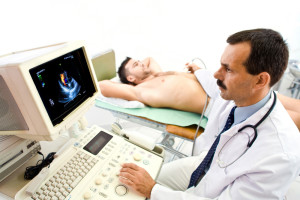The importance of echocardiograms for pulmonary hypertension patients.
For many PH patients the first step towards being diagnosed with pulmonary arterial hypertension is undergoing an echocardiogram or echo. This is an important screening test for PAH. It is also used for routine surveillance of patients once they have been diagnosed with pulmonary hypertension. It is frequently used because it is noninvasive, relatively inexpensive, and very accessible, being available in many physician offices, outpatient settings and hospitals.
 What is an echocardiogram?
What is an echocardiogram?
The echocardiogram is a simple ultrasound of the heart performed by an ultrasound technician and read by a cardiologist. It is done with the patient lying down in a darkened room. The technician uses a computer with a transducer attachment and a clear jelly like substance. The jelly substance is wiped on the skin and helps the transducer’s accuracy. This is the same technology used to look at fetuses during pregnancy. The transducer is then pushed against the patient’s chest. It emits sound waves that “echo” back when they hit an object like a heart valve allowing a moving image to be seen on screen.
This test allows the physician to examine the chambers of the right side of the heart. They can tell if they are enlarged, if their walls are thickened, and if the septum (the wall between the right and the left side of the heart) looks like it should. This test also looks at the valves of the heart and can diagnosis congenital heart disease (like holes in the heart) or abnormal fluid around the heart (pericardial effusion). It can also estimate the pulmonary artery pressures using mathematical equations and the amount of blood being jetted back into the right atrium by the right ventricle.
Findings from an echocardiogram can suggest a diagnosis of pulmonary hypertension.
There are several findings from an echocardiogram that are suggestive of pulmonary hypertension. An enlarged right atrium, an enlarged right ventricle with a thick wall, septal shift (meaning the septum of the heart has been pushed into the left side of the heart by the enlarged chambers of the right side of the heart), and of course elevated pulmonary artery pressures are some of these results.
What to do if your echocardiogram results suggest pulmonary hypertension.
If a pulmonary hypertension specialist did not perform the echocardiogram and it shows signs of pulmonary hypertension you may be referred to a PH specialist. The pulmonary hypertension expert will investigate how the results of the echocardiogram correlate with the rest of the patient’s medical information and decide if further testing for pulmonary arterial hypertension is warranted. While the echocardiogram is a useful tool, it cannot be used to officially diagnose PAH and treatment should not be initiated based on estimated pulmonary artery pressures from the echo. A right heart catheterization is currently the only way to officially diagnose pulmonary arterial hypertension.
